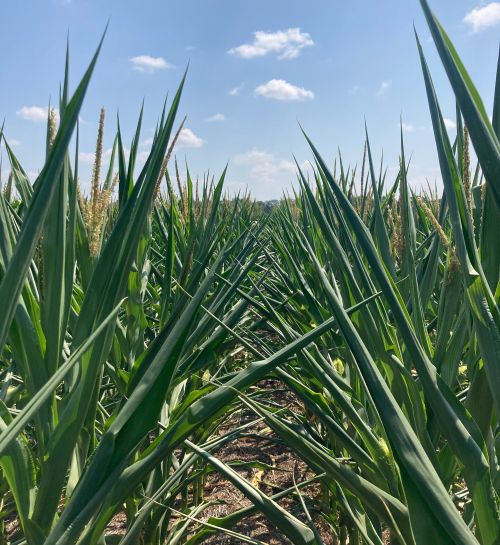Recognizing water stress and critical growth stages in corn and soybeans
When water stops, your crops speak up. From leaf rolling and flipping to flower drop, recognizing stress signs early can help you make timely decisions.

When it comes to growing high-yielding crops, timing is everything, especially when it comes to water. Water makes up 80–95% of a plant’s fresh biomass and plays a key role in various physiological processes. Water stress is one of the most limiting factors in crop production, affecting grain yield, quality and nutrient uptake. In Michigan, stress from low soil moisture often occurs during the hottest days from July through mid-August, right when corn and soybean are at their most sensitive growth stages.
Understanding when and how water stress occurs can help you protect your crop investment and make timely and informed management decisions.
What happens during water stress?
Water stress occurs when a plant’s water use exceeds water uptake from the soil, leading to a water deficit in the root zone. In response, plants activate several adaptive mechanisms: roots grow deeper for moisture, leaves may curl to reduce surface area, increase cuticle layer and stomata often close to limit water loss through transpiration.
While stomata closure helps conserve water, it also restricts gas exchange, which can hinder crop growth and development. But the effectiveness of these defenses depends on the crop type, hybrid/variety, planting date, growth stage, and severity and duration of the stress.
Plants generally use two main drought defense strategies, according to Seleiman (2021):
- Escape – speeding up development and shortening the life cycle through early flowering and maturity.
- Avoidance/tolerance – reducing transpiration, enhancing root growth, or changing leaf orientation to conserve water.
Spotting the signs of stress
One of the first physical signs of water stress in plants is reduced turgor pressure in plant cells, causing wilting and slowed growth.
In corn, early water stress is visible as leaf rolling, which reduces leaf area exposed to the sun and slows transpiration. Rolling that occurs during midday heat and recovers in the evening is normal, but if rolling begins in early morning or continues into the evening, it’s a sign of serious water stress. Prolonged stress leads to chlorophyll loss, leaf discoloration (dark green to gray), and even premature ear decline, according to Nielsen (2023) in an article on corn drought stress responses.
In soybeans, one of the early signs of water stress is leaf flipping, where leaves turn to expose their silvery-green undersides to reflect sunlight and reduce heat absorption. As stress intensifies, flowers may abort, lower leaves can drop prematurely, and the flowering period may be shortened.
Critical growth stages to watch
Understanding when your crop is most sensitive to water stress is essential.
Corn: The most critical window is from VT (tassel) to R3 (milk stage to early grain fill). Water stress during this period can cause leaf death, hastened tassel development, delayed silk development and pollination failure. However, as noted by Nielsen (2018), continued stress into grain fill may lead to kernel abortion, stand loss and premature plant death.
Soybeans: Moderate stress during vegetative stages is usually recoverable. Soybeans are most vulnerable during R3 to R6 stages (pod development to seed fill), causing flower and pod abortion, leaf drop, reduced photosynthesis and smaller seeds. Stress during R4 and R5 (early to full seed fill) can drastically reduce yield potential. For more information, refer to the article, “Moisture stress and high temperature effects on soybean yields.”
How to stay ahead of water stress
Incorporating practices that leave high amounts of crop residue on the soil surface can help conserve moisture and reduce soil evaporation. Improving soil structure also improves water infiltration and increases the soil’s ability to hold water where roots need it most.
To stay ahead of water stress, maintaining adequate soil moisture is key. Think of it as a balancing act, a literal soil-water balance. The goal is to maintain adequate soil moisture within the root zone, ensuring water is readily available to the plants when they need it most. In general, it’s recommended to keep at least 40–50% of your soil’s available water holding capacity to prevent stress. This can vary depending on your specific crop and soil type.
Tracking crop water use, weather conditions, rainfall and applied irrigation helps you make informed decisions and avoid under- or over-watering. Michigan State University Extension offers several irrigation scheduling tools and resources to help you monitor soil moisture levels and optimize irrigation water use.
Applying water at the right time and in the right amount, especially during critical growth stages, can prevent water stress before it happens, rather than reacting afterward.



 Print
Print Email
Email